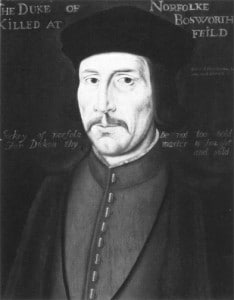
Last week I wrote about Anne Boleyn’s paternal family, the Boleyns and Butlers, so today I’m going to look at Anne’s maternal family, the Howards. Apologies for the long article, there were quite a few prominent Howards!
The Howards were one of the premier families in England and were of royal blood, being descended from Thomas Brotherton, 1st Earl of Norfolk and fifth son of Edward I, and Edward I’s brother Edmund Crouchback. They also claimed descent from Hereward the Wake, an 11th century man who led a rebellion against William the Conqueror and the Normans. The Howards have a long record of service to the monarch and the present Duke of Norfolk, Edward Fitzalan-Howard, holds the title of Earl Marshal today, just like his ancestors.
John Howard, 1st Duke of Norfolk – Anne Boleyn’s Great-grandfather
John Howard, 1st Duke of Norfolk, was the son of Sir Robert Howard of Tendring and Margaret de Mowbray, daughter of Thomas de Mowbray, 1st Duke of Norfolk. It was John’s mother who gave him his links to Edward I and Edmund Crouchback:
- Margaret was the daughter of Thomas de Mowbray, 1st Duke of Norfolk (of the first creation), (1366 – 1399)
- Thomas was the son of John de Mowbray, 4th Baron Mowbray (1340 – 1368), and Elizabeth Segrave (d.1375)
- Elizabeth was the daughter of John de Segrave, 4th Baron Segrave, and Margaret, Duchess of Norfolk (c. 1320 – 1399)
- Margaret was the eldest daughter of Thomas of Brotherton, 1st Earl of Norfolk (1300 – 1338)
- Thomas was a son of Edward I (1239 – 1307) and his second wife, Margaret of France (c.1279 – 1318)
- Margaret was the daughter of Thomas de Mowbray, 1st Duke of Norfolk (of the first creation), (1366 – 1399)
- Thomas was the the son of John de Mowbray, 4th Baron Mowbray (1340 – 1368), and Elizabeth Segrave (d.1375)
- John was the son of Joan of Lancaster (1312 – 1349) and John de Mowbray, 3rd Baron Mowbray (1310 – 1361)
- Joan of Lancaster was the daughter of Henry, 3rd Earl of Lancaster (c.1281 – 1345), and Maud Chaworth
- Henry was the son of Edmund Crouchback, 1st Earl of Lancaster and Earl of Leicester (1245 – 1296) and Blanche of Artois
- Edmund Crouchback was the brother of Edward I and son of Henry III (1207 – 1272) and Eleanor of Provence.
John supported the Yorkist cause in the Wars of the Roses. He was knighted at the Battle of Towton in 1461 by Edward IV and his offices under Edward included Treasurer of the Household. He carried the crown at Richard III’s coronation in 1483 as Lord High Steward and was created Duke of Norfolk in June 1483. Richard also made him Earl Marshal of England and Lord Admiral. He was married to Katherine Moleyns and the couple had six children, including Thomas Howard (later 2nd Duke of Norfolk), who carried the sword of state at Richard III’s coronation. John was killed fighting on Richard’s side at the Battle of Bosworth on 22nd August 1485.
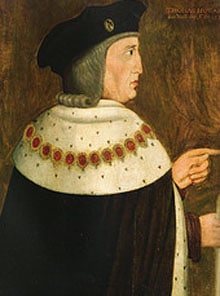
Thomas Howard, 2nd Duke of Norfolk – Anne Boleyn’s Grandfather
Thomas Howard, 2nd Duke of Norfolk, was born in Stoke by Nayland, Suffolk, and was the eldest son of John Howard, 1st Duke of Norfolk, and Katherine Moleyns. He started his court career in the late 1460s by serving Edward IV as a henchman, and was wounded at the Battle of Barnet in 1471 fighting on Edward’s side against the Earl of Warwick’s force. He was appointed an esquire of the body in 1473.
He married Elizabeth Bourchier (née Tylney) in 1472. Elizabeth was the widow of Yorkist Sir Humphrey Bourchier, who died at the Battle of Barnet, and daughter of Sir Frederick Tylney and Elizabeth Cheney. Thomas and Elizabeth had five surviving children, including Thomas Howard, 3rd Duke of Norfolk. Thomas was knighted in January 1478 at the marriage of Richard, Duke of York (Edward IV’s second son) and Anne Mowbray. When Edward IV died, Thomas carried on in royal service and took part in Lord Hastings’ arrest. When his father was created Duke of Norfolk, Thomas mas made Earl of Surrey, sworn in to the Privy Council and elected to the Order of the Garter. Both he and his father helped to suppress the Duke of Buckingham’s rebellion and, as already said, fought on Richard’s side at the Battle of Bosworth.
After Richard III was killed in battle and Henry Tudor became king, Thomas was taken prisoner and attainted for treason. He proved his loyalty to Henry VII in 1487 by refusing the opportunity to escape imprisonment during the Earl of Lincoln’s rebellion in 1487, and was restored as Earl of Surrey in 1489. He served Henry VII as a lieutenant in the north, as Lord High Treasurer and as a diplomat.
Thomas married Agnes Tylney, cousin of his first wife, following the death of his first wife in 1497 and the couple had seven children, including William Howard, 1st Baron Howard of Effingham, and Lord Thomas Howard. Thomas was an executor of Henry VII’s will in 1509 and went on to serve Henry VIII as Earl Marshal. He was created Duke of Norfolk, and his son Thomas Earl of Surrey, following his role in leading Henry VIII’s forces against the Scots at the Battle of Flodden in 1513. He was also active in putting down the Evil May Day Riots of 1517.
He resigned as treasurer in December 1522 and died on 21 May 1524 at the grand age of 81.
Thomas Howard, 3rd Duke of Norfolk – Uncle of Anne Boleyn
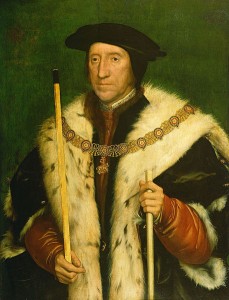
Thomas Howard, 3rd Duke of Norfolk, was born in 1473 and was the eldest son of Thomas Howard, 2nd Duke of Norfolk, and Elizabeth Tylney. He married Anne of York, daughter of Edward IV, in 1495 and although they had four children they all died in infancy and Anne herself died in 1511. He married his second wife, Elizabeth Stafford, daughter of the Duke of Buckingham in 1513 and the couple had five children, including Henry Howard, Earl of Surrey, and Mary Howard, Duchess of Richmond. The couple had an unhappy marriage and they separated in the 1530s after Norfolk took a mistress (Bess Holland) and Elizabeth accused him of domestic violence.
Norfolk was made a Knight of the Garter in 1510 and served Henry VIII as a soldier, councillor, diplomat, Lord Lieutenant of Ireland, Lord Treasurer, Earl Marshal and Lord High Steward, and was created knight of the French Order of St Michael in autumn 1532. He presided over the trials of his nephew and niece, George and Anne Boleyn, as Lord High Steward in 1536. With the Earl of Shrewsbury, he took command of the king’s forces during the Pilgrimage of Grace and presided over the brutal executions carried out in the north in early 1537. In October 1537, he stood as godfather to Prince Edward, the future Edward VI, and in 1539 he was chosen to attend Anne of Cleves on her arrival in England.
After his niece Catherine Howard caught Henry VIII’s eye in 1540, Norfolk played a role in bringing down Thomas Cromwell and was the one who “snatched off the order of St. George” from Cromwell’s neck when he was arrested for high treason. When Catherine Howard fell in November 1541, the Howards fell with her. Norfolk escaped punishment after writing a letter to Henry VIII in December 1541 distancing himself from his niece and he went on to serve the King as captain-general of the army against the Scots in 1542 and lieutenant-general of the army in France in 1544. He and his son, the Earl of Surrey, were arrested in December 1546 and taken to the Tower of London after accusations had been made regarding Surrey incorporating the royal arms into his coat of arms, showing that he had “monarchic ambitions”, and allegedly telling his sister, Mary, widow of the Duke of Richmond, to try and become the King’s mistress so that her family would be favoured. Norfolk made a confession on 12 January 1547, in an attempt to save himself but on 27 January he was found guilty of treason by attainder and sentenced to death. Fortunately, Henry VIII died before Norfolk was due to be executed. He was kept in the Tower during Edward VI’s reign but released in 1553 when Mary I pardoned him. As Earl Marshal, he carried the crown at Mary’s coronation in 1553 and in 1554 he led a force against the rebels of Wyatt’s Rebellion. He died on 25 August 1554 at Kenninghall and was buried at St Michaels, Framlingham.
Henry Howard, Earl of Surrey – Cousin of Anne Boleyn
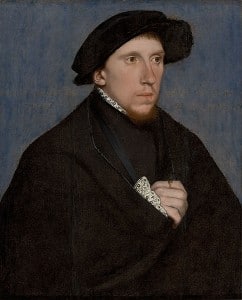
Henry Howard, Earl of Surrey, was born in 1516/17 and was the eldest son of Thomas Howard, 3rd Duke of Norfolk, and Lady Elizabeth Stafford. He spent his early childhood in Ireland, Lambeth, Suffolk and Hunsdon, before becoming a companion of Henry VIII’s illegitimate son Henry Fitzroy, Duke of Richmond and Somerset, at Windsor. The two young men accompanied Henry VIII and Anne Boleyn on their visit to Calais in 1532 and then they joined the entourage of the Dauphin which gave them the opportunity to meet poets and artists. They returned to England in September 1533 and Surrey married Lady Frances de Vere, daughter of the Earl of Oxford, in 1533. They had five children, including Thomas Howard, 4th Duke of Norfolk. Surrey was elected as a Knight of the Garter in 1541.
Surrey served Henry VIII in various offices in East Anglia and as a soldier, serving as marshal of the army in the war against France in 1544. However, he is better known as a poet and as the first English poet to discover and publish blank verse. Susan Brigden writes of how Surrey was “the first poet in English to explore what might be said without rhyme” and he is viewed as one of the founders of English Renaissance poetry and “Father of the English Sonnet”, along with Thomas Wyatt and, I believe, George Boleyn.
He was found guilty of treason on the 13th January 1547 at a common inquest at Guildhall, where evidence was given “which concerned overt conspiracy as well as the usurpation of the royal arms”. It was alleged that “he had on 7 October 1546 at Kenninghall displayed in his own heraldry the royal arms and insignia, with three labels silver, thereby threatening the king’s title to the throne and the prince’s inheritance”. His trial lasted a day and he gave a spirited defence but it was no good, he was found guilty and sentenced to death. Surrey spent his last days in the Tower writing, and paraphrasing Psalms 55, 73 and 88. He was executed by beheading on Tower Hill on 19 January 1547 and was laid to rest at All Hallows-by-the-Tower (All Hallows Barking), but his remains moved in 1614 by his son Henry, Earl of Northampton, to a beautiful tomb in the family church, St Michael’s at Framlingham.
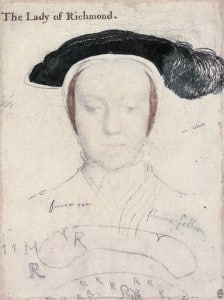
Mary Howard, Duchess of Richmond – Cousin of Anne Boleyn
Mary Howard, sister of Henry Howard, Earl of Surrey, was born in around 1519. She attended Anne Boleyn when she was created Marquis of Pembroke in September 1532 and served as one of her ladies when she was queen. She was chosen to carry the chrism at the baptism of Princess Elizabeth (future Elizabeth I) in September 1533 and on 25 November 1533 she married Henry Fitzroy, Duke of Richmond and Somerset, Henry VIII’s illegitimate son. Their marriage was never consummated, due to their youth, and Richmond died in July 1536. Mary never remarried, although her father was keen on a match with Thomas Seymour, brother of Queen Jane. Mary was not keen on the match.
Mary fell out with her brother Henry at some point, and gave evidence against her brother in December 1546. After his execution, she took on the responsibility of educating his sons and appointed martyrologist John Foxe as their tutor. She is thought to have died in late 1555 (some say 1557) and was laid to rest alongside her husband in St Michael’s Church, Framlingham.
Like her brother, Mary was a poet and, with Mary Shelton and Margaret Douglas, contributed to an anthology now known as the Devonshire manuscript
Edmund Howard – Uncle of Anne Boleyn
Edmund Howard was born in 1478 and was the younger brother of Thomas Howard, 3rd Duke of Norfolk, and father of Catherine Howard, Henry VIII’s fifth wife. He commanded men at the Battle of Flodden in 1513 and in 1531 was appointed as Comptroller of Calais. By 1515 he was married to Jocasta Culpeper, son of Sir Henry Culpeper of Oxenhoath, and widow of Ralph Legh, and the couple had six children, including the future Queen Catherine Howard. It is not known when Jocasta died, but Edmund had married Dorothy Troyes, daughter of Thomas Troyes of Hampshire and widow of Sir William Uvedale, by 1528. When she died, he went on to marry Margaret Munday, daughter of Sir John Munday and widow of Nicholas Jennings. His second and third marriages were childless. The children he had with Jocasta, combined with the fact that he had to provide for Jocasta’s children by her previous marriage, caused him to suffer financial difficulties for the rest of his life. He acted a chief mourner at his sister Elizabeth Boleyn’s funeral in April 1538 and he died in March 1539.
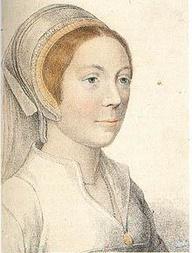
Catherine Howard – Anne Boleyn’s cousin and fifth wife of Henry VIII
Catherine Howard was born sometime between 1520 and 1524 and was the daughter of Edmund Howard and Jocasta Culpeper (see above). By 1531, it appears that she had been sent to join the household of her step-grandmother Agnes, Dowager Duchess of Norfolk. She resided with the dowager duchess at her homes in Lambeth and Horsham from that time until she was chosen to serve Queen Anne of Cleves in late 1539.
Catherine married Henry VIII in July 1540 and was executed in February 1542. You can read more about her life in my article The Marriage of Henry VIII and Catherine Howard and in the following articles:
You can read about the Boleyns in Anne Boleyn’s Family Part One – The Boleyns.
Notes and Sources
- Oxford Dictionary of National Biography – articles by Beverley A. Murphy, Susan Brigden, Michael A. R. Graves, David M. Head and Anne Crawford.
- Byrne, Conor (2014) Katherine Howard: Rose without a Thorn, unfinished manuscript.